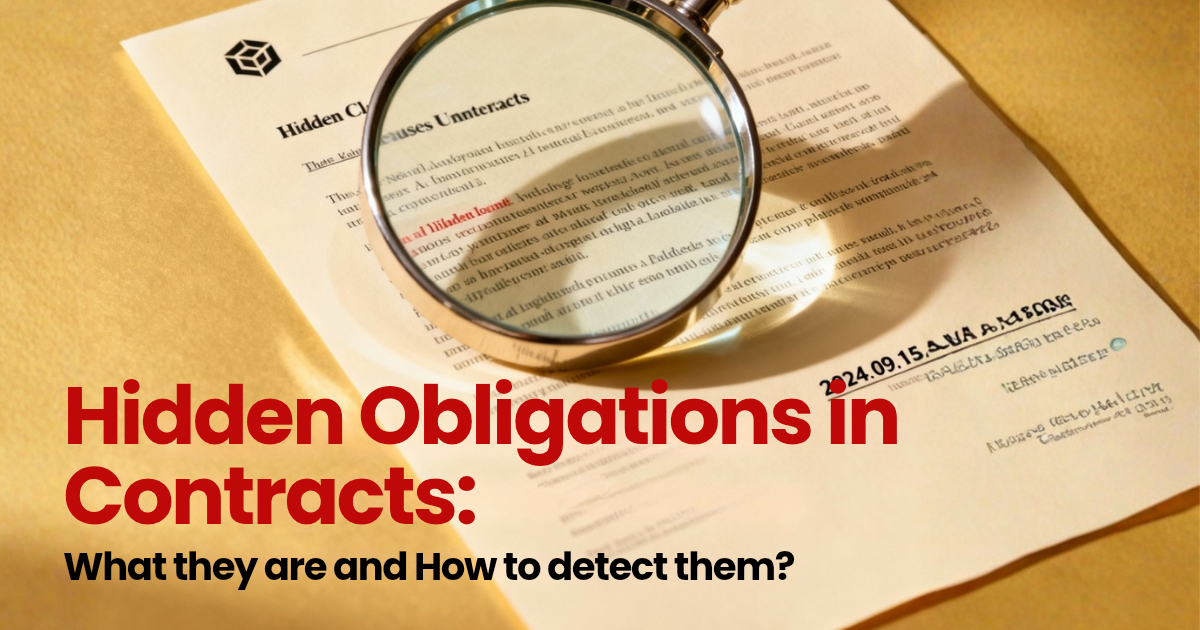Hidden Obligations in Contracts: What They Are and How to Detect Them

Ever signed a contract that looked straightforward until unexpected costs, new requirements, or surprise penalties popped up later? Those surprises often arise from hidden obligations. They're the silent traps that can turn what seemed like a fair deal into a financial headache.
In today's fast-paced business world, understanding these hidden obligations in contracts isn't just about legal caution. It's about protecting your business and maintaining trust in business relationships.
Let's break down what they are, why they matter, and how you can detect them before they cause trouble.
Hidden obligations are commitments buried deep in agreement language and sometimes unintentionally due to legal complexity and sometimes these obligations are not easy to spot because they are hidden in complicated language, unclear wording, or placed in extra documents attached to the contract.
Here's what they often look like in practice:
- Implied contractual terms: Obligations that aren't written down but are
assumed
by law, industry custom, or business necessity. - Buried clauses: Unfavourable conditions buried in long paragraphs or complex legal sections, sometimes even in attached schedules.
- Ambiguous language: Phrases like
reasonable efforts
oras needed
that sound harmless but can create room for dispute later.
These hidden terms can quietly establish financial, operational and legal responsibilities you didn't plan for.
1. Financial Traps
Ever noticed fine print about renewal fees
, service charges
, or administrative costs
? These are classic examples of financial traps. Hidden financial obligations can also come from escalation clauses that automatically increase prices, or silent renewal terms that holds you longer than you expected.
2. Performance Commitments
Contracts may promise "industry-standard quality" or "timely delivery" but what do those really mean? Without specifics, performance obligations become open-ended liabilities. Implied warranties can also add quality guarantees that you didn't explicitly agree to.
3. Compliance Requirements
Sometimes the law itself inserts terms into contracts, even if they're not stated. Employment laws, consumer rights, or environmental standards might impose compliance duties that your contract doesn't mention. But you're still legally accountable for them.
4. Indemnity and Liability Gaps
Watch out for broadly worded indemnification or liability clauses. They can make your business responsible for damages, legal fees, or risks beyond your control, especially if the wording is one-sided.
Hidden obligations are often buried deep but not invisible. A few structured review techniques can help uncover them. Let's discuss them below.
- Language Red Flags: Scan for unclear or open-ended terms such as
reasonable
,industry standard
ormutually agreed
. These phrases may sound cooperative but can later expand your responsibilities. - Structural Review: Don't just read the main body of the contract. Check schedules, related documents, and attachments. They often contain critical details like fee escalations or delivery conditions. Cross-references create hidden dependencies by linking separate pieces of information, which can trigger unexpected duties and obligations. In contracts, legal documents, and technical manuals, this can lead to serious consequences if the connections are not fully understood.
- Financial Review: Go beyond the pricing page. Check for hidden charges, late-payment penalties, or automatic renewals. Ask for detailed cost breakdowns and negotiate fixed pricing or caps wherever possible.
Contract review technology is transforming how businesses handle risk. Modern AI-powered contract analysis tools can scan thousands of documents, identify risky clauses, and highlight deviations from standard wording.
These tools apply natural language processing (NLP) to detect patterns human reviewers might miss. These are flagging obligations, deadlines and compliance risks. Advanced systems even track fulfillment over time,alerting you to upcoming responsibilities long before they become problems.
In short, AI takes contract management from reactive to proactive.
1. Build a Strong Due Diligence Process
Design a contract review checklist that covers every section, including attachments and related agreements. Involve your legal, finance, and operations teams so no obligation slips from your contracts.
2. Rely on Legal Expertise
Even the best AI cannot replace the insight of experienced legal professionals. Having a lawyer who reviews complex or high-stakes agreements ensures hidden risks are caught in early stages.
3. Document and Track Everything
Create an obligation register, which is a central system to track key terms, ownership, and deadlines. Also use automated reminders so nothing gets missed.
4. Standardize Contract Language
Use pre-approved templates and clause libraries that reflect your organization's risk policies. When vendors propose new language, you'll immediately spot deviations that could create hidden exposures.
5. Monitor Continuously
Contract risk isn't static. Regulations evolve, partnerships change, and obligations shift over time. Set up recurring reviews daily for critical obligations, weekly for moderate risks, and monthly for lower-priority items.
Turning Risk into Control
Hidden obligations don't have to be business deal-breakers. When you combine thoughtful legal review, structured processes, and AI-driven insight, you gain visibility and control.
The ultimate goal isn't just to detect these obligations, it's to transform them into measurable and manageable commitments that align with your business strategy.
Thinking about finding hidden obligations in your contracts. Then start your free trial now.
Also read : Hidden Contract Risks That Drain Business Revenue (and How AI Solves Them).
Ankit Singh
October 21, 2025